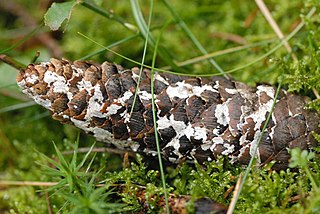Related Research Articles

Phanerochaete is a genus of crust fungi in the family Phanerochaetaceae.

The Corticiaceae are a family of fungi in the order Corticiales. The family formerly included almost all the corticioid fungi, whether they were related or not, and as such was highly artificial. In its current sense, however, the name Corticiaceae is restricted to a comparatively small group of mainly corticioid genera within the Corticiales, though the family is as yet not well defined.

Atheliaceae is a family of corticioid fungi placed under the monotypic order Atheliales. Both the order and the family were described by Walter Jülich in 1981. According to a 2008 estimate, the family contains 20 genera and approximately 100 species. However, many genera formerly considered to belong in the Atheliaceae have since been moved to other families, including Amylocorticiaceae, Albatrellaceae, and Hygrophoraceae. Despite being a relatively small group with inconspicuous forms, Atheliaceae members show great diversity in life strategies and are widespread in distribution. Additionally, being a group strictly composed of corticioid fungi, they may also provide insights on the evolution of fruiting body forms in basidiomycetes.

The Phanerochaetaceae are a family of mostly crust fungi in the order Polyporales.

Byssomerulius is a widely distributed genus of crust fungi.
Candelabrochaete is a genus of crust fungi in the family Phanerochaetaceae.

Phlebia is a genus of mostly crust fungi in the family Meruliaceae. The genus has a widespread distribution. Phlebia species cause white rot.

Mycoaciella is a genus of corticioid fungi in the family Meruliaceae. The genus was circumscribed by John Eriksson and Leif Ryvarden in 1978. After microscopic examination of the three species then in the genus, Karen Nakasone proposed to synonymize Mycoaciella with Phlebia.

Scytinostromella is a genus of crust fungi in the Stereaceae family. The widespread genus contains five species. The genus was circumscribed by Estonian mycologist Erast Parmasto in 1968, who set Peniophora heterogenea as the type species. Characteristic features of the genus include dimitic hyphae, spores that are both amyloid and asperulate, and the presence of cystidia and rhizomorphic strands.
Uncobasidium is a genus of two species of crust fungi in the family Meruliaceae. The genus was circumscribed by mycologists Kurt Hjorstam and Leif Ryvarden in 1978 with the European fungus U. luteolum as the type species. The South American species U. roseocremeum was added to the genus in 2012. The distinguishing feature of Uncobasidium is the basal hook in the basidium.

Dentocorticium is a genus of six species of poroid fungi in the family Polyporaceae. The genus was revised in 2018, with several new species added and some older species transferred to other genera, based on phylogenetic analyses.

Skeletocutis is a genus of about 40 species of poroid fungi in the family Polyporaceae. The genus has a cosmopolitan distribution, although most species are found in the Northern Hemisphere. Skeletocutis causes a white rot in a diverse array of woody substrates. Their fruit bodies grow as a crust on the surface of the decaying wood. Sometimes the edges of the crust are turned outward to form rudimentary bracket-like caps.

The corticioid fungi are a group of fungi in the Basidiomycota typically having effused, smooth basidiocarps that are formed on the undersides of dead tree trunks or branches. They are sometimes colloquially called crust fungi or patch fungi. Originally such fungi were referred to the genus Corticium and subsequently to the family Corticiaceae, but it is now known that all corticioid species are not necessarily closely related. The fact that they look similar is an example of convergent evolution. Since they are often studied as a group, it is convenient to retain the informal (non-taxonomic) name of "corticioid fungi" and this term is frequently used in research papers and other texts.

Sistotremella is a genus of corticioid fungi in the family Hydnodontaceae. The genus has a widespread distribution, and contains four species.
Dextrinodontia is a fungal genus in the family Hydnodontaceae. The genus is monotypic, containing the single species Dextrinodontia molliuscula, found in Tanzania.
Melzerodontia is a genus of toothed crust fungi in the family Corticiaceae. The genus contains three species that are found in Africa.

Xenasmatella is a genus of corticioid fungi in the order Polyporales. Circumscribed by German mycologist Franz Oberwinkler in 1966, the widespread genus contains 14 species.
Lyoathelia is a fungal genus in the family Atheliaceae. The genus is monotypic, containing the single corticioid (crust-like) species Lyoathelia laxa. Originally found in Canada, it is now known to occur as well in the United States and Japan.
Crustodontia is a fungal genus of uncertain familial placement in the order Polyporales. The genus was circumscribed in 2005 to contain the crust fungus Crustodontia chrysocreas. This species was originally described as Corticium chrysocreas by Miles Berkeley and Moses Ashley Curtis in 1873. Their description was as follows: "Subiculum bright yellow, thin; hymenium immarginate pallid, or yellow tinged with tawny." Crustodontia has a monomitic hyphal system, meaning it contains only generative hyphae, and these hyphae have clamp connections.

Anthoporia is a fungal genus in the family Meripilaceae. It is a monotypic genus, circumscribed in 2016 to contain the single species Anthoporia albobrunnea.
References
- ↑ "Fibriciellum silvae-ryae J. Erikss. & Ryvarden 1975". MycoBank. International Mycological Association. Retrieved 2011-12-01.
- ↑ Larsson KH. (1992). The genus Trechispora (Corticiaceae, Basidiomycetes). Göteborg, Sweden: University of Göteborg. p. 19. ISBN 978-91-86022-66-2.
- ↑ Kirk PM, Cannon PF, Minter DW, Stalpers JA (2008). Dictionary of the Fungi (10th ed.). Wallingford, UK: CAB International. p. 256. ISBN 978-0-85199-826-8.
- ↑ Eriksson J, Ryvarden L (1975). The Corticiaceae of North Europe. 3. Oslo, Norway: Fungiflora. p. 373.
| | This Agaricomycetes-related article is a stub. You can help Wikipedia by expanding it. |